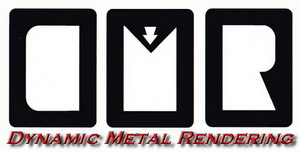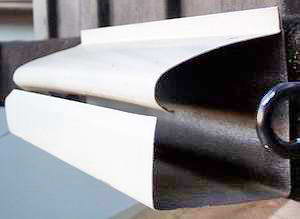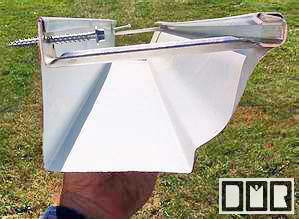|
The Steel Vs. Aluminum Argument |
| We are told
how steel is a lot stronger than aluminum, and it seems to be
true, so why should I favor aluminum gutters? Or what about stainless-steel
and copper?
DMR Gutters will refuse to install steel gutters because it goes against our
ethics
 Galvanized Steel Galvanized Steel
It is now very rare to see galvanized steel gutters,
other than some very thin short parts found at the hardware stores,
which are
not to Building Code thickness and will not last even 10 years, which
would be a waste of money and effort to install, so this is more
of a non-issue. I've seen some flashing made of Galv-alum, but I have not seen this used for gutters
yet.
Painted Steel
All the gutter coils sold here are painted mild steel
sheet-metal that has not been galvanized under the paint. Anything is only
as good as it's weakest link and these do not have nearly the quality paint
than most any car finish has. It scratches a lot easier and will become
faded and chalky within a decade. I would say they are painted with less than
half as many coats and has no clear coat over it. Even if it was the same
quality what car paint have you seen
that lasts over 2 decades? These gutters will never get waxed like a car does, so they are
not expected to hold up nearly as long regardless of what claims their Sales
Rep might say. I have not yet seen them sell a steel with
a powder baked surface like the leaf screens have that I use, so don't fall for that fairy tale either.
(a) Strength, the bold-face lie!:
Their best arguments for steel is how it is more rigid
than aluminum. It would be true, but they neglect to add how Building
Code requires all professional aluminum gutters to be formed with
sheet-metal that is almost twice as thick as professional steel gutters to compensate for this short
coming aluminum has. It is a high grade aluminum alloy mix that is stiffer
than just aluminum by it's self. So it is about twice as thick and is not a metal that will
rust if the paint were to completely flake off. As long as it is installed well with moderate care and
cleaning there should be little to no reason you'll to need to replace them in the
future. They can be cleaned and repainted with the house when that time
comes back around, which you know will be needed before long. Damaged gutters from some sort of impact only
accounts for less than 10% of gutter replacement, so even if there was a
difference damage is still a minor concern. Steel gutters will
not resist any substantial impact and they cannot be repainted inside, so
they fail in short order by rusting holes through the bottom floor of the
gutter, which accounts for around 75% of gutter replacement.
The wholesale suppliers to professional Gutter
Contractor
do not sell steel sheet-metal coils in a thicker grade, since the rigidness
of a thicker steel would only jam in the roll forming machine they
use to form the gutters on-site. If they some how replaced the motor
in that machine with a stronger one to handle this thicker metal, it would
soon ruin the roller-bearings in that machine that are needed for the
rollers to shape the metal into the gutter shape.
That is why stainless steel gutters are rarely talked about, let alone seen
on any houses. For
this reason, the local wholesale suppliers do not stock stainless steel
coils. So if you want stronger gutters; 20oz copper is pretty much your only
option. Copper is a very malleable metal, but the 20oz copper does bog down
our machine quite a bit. The machine is just barely able to push it through.
(b) Looks: Their second best claim is that "you will want to
replace your filthy gutters after 15 years anyway for nice shiny new ones that are the latest
fashion and color! So rusting gutters is a non-issue" This may
be true for some people. How do you feel
about that argument; suggesting planned obsolescence? Rusting gutters accounts for the majority of
our gutter replacement by far. If that does not tell you the good and
bad of gutters, what could? The way I see the true looks of steel gutters is the permanent
rust stains on the surfaces below it. Even when the rusty steel is
replaced, the stain damage remains. Besides that most of what you are
paying for is their labor, business expenses and profit. A small
percentage of what your end cost is the cost of the materials used, so a
cheaper metal that will not last is actually a lot more expensive in the
long run.
(c) Longevity: Standard
steel gutters will rust through within 10 to 30 years;
depending on how clean they are kept and the amount of tree fall-out
your roof is subject to. In this area we have a lot of tall trees and most
Homeowners do not keep
their gutters well maintained, so we need to be realistic here. Plenty of
replacements are because
of poor
installation, but that is still not the majority. I've replaced some very expensive
custom steel gutter systems on businesses and churches that were over 4 times as thick as standard steel gutters,
yet even those super thick steel gutters had rusted completely through the bottom within three decades.
Aluminum gutters would have been less than half the cost of those custom
gutters.
They were so thick they had to be welded together at the seams. One
of these were on a Stuart Anderson Cattle Co. Restaurant over 15 years
ago, so I know they could not have been more than 30 years old, but those
very expensive steel gutters had still failed in far less time that
aluminum gutter would have.
(d) Expansion and Contraction: Proponents of steel will
exclaim how
aluminum will expand and contract
far more than steel. Steel being a much more stable metal. It is
true there does seem to be a
slight difference between these two metals. We are talking about maybe a
millimeter per
10' length. That statement is assuming a wood structure will not shift and
change as well. You need to garner cautionary claim with the obvious motivations
of those Sales Rep who push steel. Expansion and contraction needs to be factored in with
any long gutter system regardless. Although a detail they will not properly
factor in the installation from the many thousands of steel gutters I've
replaced.
Perhaps if you are i need of gutters for a steel pole building
perhaps
steel gutters would expand at a similar rate, but the thickness of the steel
of the pole barn structure will affect this issue, so they are not likely
to expand the same as thin steel gutters. It is more how they are installed
that will make a difference as to potential problems. It is advised to
not install aluminum or steel gutters longer than 40' to 50'.
Especially if the ends of the gutters are attached to another gutter at a
corner. You cannot make a seamless corner, so the change in
temperature can cause the metal length to change, where it can only push and tug
on those corners; pulling them apart. Long gutters need an expansion joint
in the middle to relieve this tension.
In an extreme case I've seen where a gutter contractor installed a pair
of gutters that were 150' each, overlapping to connect them in a 300' long
straight side of that commercial building. That other gutter
contractor would have made it in one piece, but they did not have the
manpower to install that long of a gutter. The seam not only pulled
apart and leaked. It ripped one gutters off the building, and the other
would have followed in time. There were 5 downspouts on that side of the
building, so I was able to break it up into 5 separate gutters of around 60'
each. That was still longer than I should have done, but I had little choice.
I
then capped over the two end-caps that were near each other, so it would not
dribble between them and added a 1' piece of gutter under it with the bottom
bent wider to hid the gap. Another alternative I have done is to design the ends of the gutters to be at the downspouts to
dump into a scupper. If there is not
enough downspouts to do this, there is a rubber expansion joint as well that
can be used. They are hidden inside the ends of two overlapping
gutters, but will jam with debris if not cleaned out frequently.
(e)
Leveling:
Most steel gutters will last about 15
years. Maybe more if they are kept very clean and were leveled
properly when they were installed
(which is very rare to
find), so that there is no standing water in
them. The main problem with this is that from what I've seen from
the removal of over a couple thousand sets of gutters, most installers do
not even use a level to compensate for such irregularities on a house (which
I do see on most every house), so few steel gutters will last.
 Even new houses are not built truly level. With all my gutter
installations I actually add a
slight grade towards the outlets, so there is not only no chance there can be any standing water,
but they should rinse themselves out in a heavy downpour. The
only time I wouldn't install gutters with this downward grade is if the
home owner insisted. I would caution them again about the
benefits of a healthy grade, but must leave the final decision up to the home
owner. Luckily, this is rarely an issue, but my installations will
look more crooked than others to be more functional. Even new houses are not built truly level. With all my gutter
installations I actually add a
slight grade towards the outlets, so there is not only no chance there can be any standing water,
but they should rinse themselves out in a heavy downpour. The
only time I wouldn't install gutters with this downward grade is if the
home owner insisted. I would caution them again about the
benefits of a healthy grade, but must leave the final decision up to the home
owner. Luckily, this is rarely an issue, but my installations will
look more crooked than others to be more functional.
There is no real advantage to steel, other
than the cost. With labor being the majority of the cost, the cost
difference is clearly not worth the disadvantages listed here. You will
do well to not hire any gutter contractor who pushes steel, and to find a
contractor that will install rust-free gutters correctly.
I refuse to install steel gutters, for we do not
believe in planned obsolescence! It would go against our ethics. That
is one point we will not concede.
Aluminum
Manufacturers typically claim a 20 year warranty on the paint finish,
and aluminum sports a 40 year to life-time warranty on it's failure,
depending on the companies moxy.
Aluminum has been used in making gutters for over 50 years now and we have yet to find aluminum gutters
that had rotted through the bottom. The only reason that I've had
to replace aluminum gutters is because of poor installation, or
because of damage from fallen tree branches or a truck being backed into
them. Although dents are more the rarity.
Keep in mind that steel gutters really do dent just as easily.
Remember, steel may be strong, but a much thinner sheet-metal (see (a)
above).
Stainless Steel
Stainless steel is stronger than steel, but because of this it is even a
little thinner than the steel sheet metal used for gutters, so that blows
this advantage. Since stainless steel is about the same cost as copper, it is rarely sold, hence the wholesale suppliers do not carry a stock of stainless steel. It is also rather odd looking on a house,
since it remains that shiny silver. We have seen roof valley on the
Mormon churches we've worked on that are stainless steel, and they
remain a bright eye sore. They should have used copper, since it is
about the same cost for thicker metal, and is a metal that is meant to be seen.
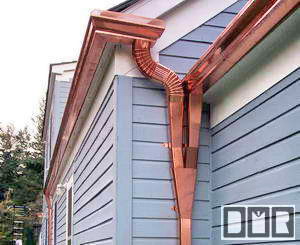 Copper Copper
Copper gutters are a good way to go for several reasons. I try
not to push copper gutters, but the one practical advantages are how
you will have no need to deal with the painting or even cleaning issue again,
since they will not mildew. Although a lot of Homeowners buy copper gutters for the bragging points. It is the posh thing to have.
|
|
Plastic
Gutters |
| What
about plastic gutters that will never rust?
We have replace lots of plastic
gutters, and here are some of the logical reasons why they are simply a
waste of money:
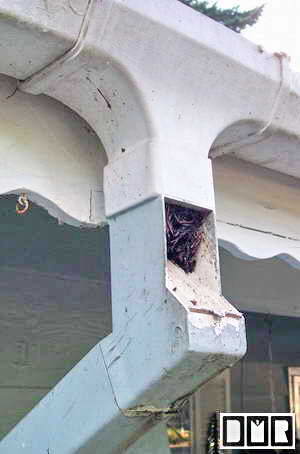 (a) Plastic gutters are even
worse than steel gutters. They may not rust, but the sun will break down the plastic within a decade and they become very
brittle. Depending on how clean you keep your gutters, steel gutters will last about 15
to 20 years at least. (a) Plastic gutters are even
worse than steel gutters. They may not rust, but the sun will break down the plastic within a decade and they become very
brittle. Depending on how clean you keep your gutters, steel gutters will last about 15
to 20 years at least.
(b)
Even when the plastic gutters are new, they do not
have the support to lean a ladder against them to clean them out or access
the roof. Don't try to lean a ladder against
them, or they will collapse and or crack, depending on how old they are.
(c) The rubber seals that join plastic gutters at every 10
foot section are made of a cheap rubber and they seem to fail in even less
time than the gutters.
(d) The exterior supports are unsightly. Do you want to
look at your house and see it look to have obvious exterior
plumbing on it?
(e) Plastic gutters are not recyclable, which
means we have to pay an extra dump fee to get rid of them. There for
adding to our land fill problem. We also have to charge more for
removal to cover the disposal cost.
(f) The connecting parts are so expensive, it can cost almost as
much as hiring us to install aluminum gutters.
(g) We refuse to install plastic gutters, for we do not
believe in planned obsolescence! It would go against our personal
ethics.
(h) Most of the plastic gutters you see are just amateur
parts bought from the local hardware store by do-it-yourselfers, and are
poorly installed.
There is no good application for Plastic gutters! Enough said?
|
| Fashions
and Styles |
| Will
the K-5 gutters you install look best on my house and be up with the
latest fashions for housing trends? Fashions need to change over
time. Back in the early 70's they came out with the plain face fascia
type gutter look to give a more modern appearance to these simple
houses. It took time to transition over to these from the previous standard K-5
gutter, but over the last few decades it had come to be the standard for
over 90% of the new construction through the 80's and 90's.
 The real reason general contractor switched over was the
money they saved: The real reason general contractor switched over was the
money they saved:
1. They had reverted to installing cheap steel gutters instead of
aluminum, since the CCB only requires a one year warranty.
2. These gutter machines were cheaper with a much simpler set of rollers
to form these fascia gutters with fewer bends to it.
3. This taller profile allowed the general contractor to save by not
installing any fascia boards on the rafter tails.
4. They also saved money by having this gutter machine bend a small
1/2" lip on the back side; that is to go over the plywood edge.
This way the roofers did not have to install the standard 1"x 3"
dripedge flashing at the roof edge any more.
5. This lip over the plywood roof edge also eliminated the need to use a
level when installing gutters, since there was no choice to do anything
other than install the gutters straight with the roof edge. This
sped up the installation process, again saving a lot of money.
6. They also gifted you with a more modern look by not purchasing the
curved downspout elbows any more. They just cut the straight
downspout pipe with a hacksaw and folded it. This works well if you
have a debris free situation, but tends to cause an annoying dripping
noise inside these tin downspout pipes. I have even seen them do
this on a copper set of gutters on a Street of Dreams house in 2003, if
you can believe that?
In this new century, fascia gutters are getting real old
after the last 30 or so years of dominance. Not to mention they
simply do not work well. I see the trend reversing to the previous
k-5 style wood molding shaped gutter.
 This is because there
is no other good option to go with: This is because there
is no other good option to go with:
(a)
The
Leaf
Guard ®
gutters and other similar types only work in debris free situations
(see
our Comparison Web Page for details).
also they are far too expensive, since they cost as much as expensive
copper gutters. General contractors work to keep housing
prices down and maximize their profits, so they are far too cheap to ever
go that route. That is why you never see copper gutters on a
new house, unless it was specifically ordered that way by the buyer and
are willing to pay through the nose for them.
(b)
Even though the older half round gutters are cheap, since they take
less sheet metal to make a 5" gutter, they were made from one of the
very first continuous gutter machines, before they developed more complex
gutter machines, and were obsolete about half a century ago. They
are a terrible way to go, since they are too shallow, very hard to level,
do not have the strength to resist the pressure of a ladder against them,
and look worse than plastic gutters; in that they look even more like your
house was fitted with external plumbing pipes. Because these
half-round gutters are crap and ugly, there are very few Gutter Contractor in the USA who still have a half-round gutter machine, so they
could never keep up with the demand of new construction.
(c) See just
above for the reasons the plastic gutters
are utter garbage.
I do not know of any other viable options out
there. There is a push to make houses with a more classic styling as
well, so that is why the K-5 wood molding shape is coming back in style.
Even when they were making the older half-round gutters, the K-5 gutter
would have been what looks better on those houses to match the existing
wood molding, but they simply did not have that option back then.
Gutters should be as inconspicuous as possible.
|
|
Sturdy
Installation |
 What is a
right way to install
gutters? What is a
right way to install
gutters?
(a) Each time the gutters are replaced, it tears up and weakens the
wood that the gutters are attached to, so I gave up installing gutters with nail spikes
over 10 years ago. In fact, I only used them once. I realized
right off the bat how terrible they were. So I researched for a
better method. I use an extra strength hidden hanger, with hex head galvanized wood
screws that I order from a supplier back East, since the supply and demand
is such that the local suppliers have do not have the incentive to stock
the better parts that are available.
(b) I place these hidden hangers every two feet, which
is twice that of building code. Placing them every 2 feet is especially helpful when you lean a
ladder on them to clean out your gutters, or when someone needs to work on
your roof. It is far less likely to dent and cave in. These brackets are more common where they have
severe ice storms, and they have whole sheets of ice would slide off the roof and just slam the
gutters off the house. They also leave a much smoother appearance, like the wood molding
they are to resemble.
(c) We all know how screws hold a lot better than
nails. In the old days they did not have a steel molding process to
mold screws, so they had to be turned on a lathe from a solid stock of
steel. Nails were the only thing that was affordable. These
days we do have inexpensive screws. They do still cost more than
nails of course, but they would only add a tiny amount to the whole
contract cost. the best part about screws is that if the wood I am
attaching to splits and cracks, or there is too much dry-rot, or even if
the screw strips out the wood it is suppose to grip to, I will always know
it. The screw will not cinch down tight and I will not feel the
drill kick back. It will just continue to spin. I then can
back out the screw, change the angle, move the bracket, or change to a
longer screw. I know if it takes every single time. Nails will
not be able to give the installer that kind of indication.
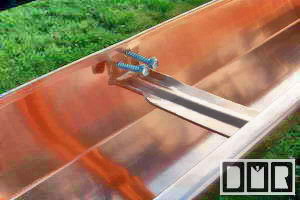 (d)
It is a fact that most installers in the NW are still using nails
in these modern days, since all they care about is the bottom line.
It is simply because the Gutter
Contractor are too cheap to buy and replace a powerful $300 18v Makita
cordless impact driver like I use. Also a lot cheaper to
replace when they get lost or stolen. (d)
It is a fact that most installers in the NW are still using nails
in these modern days, since all they care about is the bottom line.
It is simply because the Gutter
Contractor are too cheap to buy and replace a powerful $300 18v Makita
cordless impact driver like I use. Also a lot cheaper to
replace when they get lost or stolen.
(e) When we are installing a 55 foot long gutter on a
house, the hidden hangers are all in place with the screws started in the
back, which stabilizes the gutter a great deal. It only takes one
person to install it. It may be bowing a bit, I set the center
screw, I cannot see quite how the end fits to the edge of the roof.
I go to the end of the gutter and measure how far I need to reset that
center screw, then I go back to the middle and reset that screw. I
go to that end that is away from the outlet and pull it up as high to the
roof as possible and set that screw. I then work the level, giving
it a slight grade down towards the outlet and set the screws as I work my
way to the center. Most times the center screw is not set to the
right height, so I then reset it again. I then work my way to the
other end. You cannot do that with nails. Enough said?
|
|
Snow Damage |
| What
about the damage caused by icy snow sliding off the roof and denting and or
dislocating the gutters?
Back in 1994, I was removing one short 16' gutter,
without bothering to cleaning the leafy debris first, not guessing that
the Mt. St Hellens ash was still in the gutter under the leaves since
that 1981 blast. When I removed the last nail spike, the weight of that
gutter was so much that it dropped out of my hand and dented the metal
shed under the gutter. We had not seen that sort of trouble since Mt. St. Hellens first blew and the weight of the ash the washed down off the
roofs pulled a lot of gutters off houses well before I began to do
construction work. This issue had been the main motivator for my
doubling up on gutter support brackets and using only screws to install
gutter, since I began doing professional gutter installations over a
decade ago.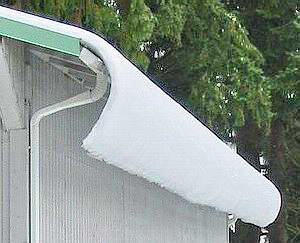
This snow damage issue had not been much of a problem here
in the Portland Metro area, since we normally do not get those sort of
weather conditions here. But in the Winter of 2003/04 we did get a serious
weather condition that did damage a lot of gutters. This was especially a
large problem with metal roofs, where the house would warm up the snow from
underneath and the snow would slide off, even on low slope 4/12 pitch roofs.
Even with a few of the gutter installations we did, that snow broke off the
screw heads the held the gutters up. Believe it or not, the aluminum gutters
and brackets held up, but we saw that we needed to prepare better for the
future and compensate for this sort of natural disaster.
We began in early 2004 to change over to stainless steel
screws and to double up on each hidden hanger bracket. So it equals one
screw per foot of gutter, which is 4 times the building code for gutters.
We wrote up a whole web page devoted to this issue, s
click on the photo above to read more and see other photos.
|
| Level
or Graded
Gutters |
| Do
gutters need special leveling, other than just straight with the roof line?
In talking with home owners and
from replacing several thousands of sets of gutters, I’ve found that few installers even bother to
use a level when installing gutters. They just install them straight
with the roof edge, in hopes that the structure is not so out of level
that the top of the gutter opposite the outlet is not lower than the
bottom of the gutter at the outlet. It is true that it does not take
much debris in the gutter to upset this balance and cause the gutters to
over flow at the low point, but even beyond the fact they are only
required to provide a one year warranty, the Gutter Contractor can simply
claim no responsibility to keep your gutters clean. Fascia gutters
are even deeper, making the margin for error even harder to detect.
Most fascia Gutter Contractor set their machine to
bend the backside of the gutter to lay over the roof's edge. Although this installation does
not allow the option to level or grade the gutters down toward the outlet,
so that it would rinse themselves out in a heavy downpour. I have yet to work on a house that is properly
level, let alone was built intentionally sloped to drain toward the outlets.
It’s not unusual where I have had to drop the
gutter down 2" or more at the outlet, just to level the gutter.
If I work to give the gutters a slight grade down to the
outlet, they not only will better be self cleaning, there is much less
chance there will be any standing water in the gutter to possibly cause
problems in the future, so they will likely last far more than a
year. They also will not be breeding ground for mosquitoes and
smelly bacteria from the decaying debris. That is why cleaning
gutter gunk smells like S - H - I - T. I sure hope you use gloves
when cleaning out your gutters!
|
| Drip-edge
Roof Flashing |
| What
is drip-edge roof flashing, and why do I need it?
A proper drip-edge roof flashing is suppose to
be installed across the roofs bottom edge by the roofer before the
shingles are nailed down over it. It is normally made to reach up 3"
under the edge of the shingles, and hang down an inch into the gutter, but
can easily be made to a custom fit and made with a safety hem toi hide the
sharp edge of that metal.
 A far cry better from the tiny half-inch lip on
those
cheap steel fascia gutters, compared to the 3" reach of a standard drip-edge
flashing. One of this flashings primary functions is to keep the
rain water from soaking the plywood or chip-board along the edge, just under the roofing shingles,
which would cause substantial dry-rot and damage to the edge of your
roof, which would be very hard to replace and quite expensive. A far cry better from the tiny half-inch lip on
those
cheap steel fascia gutters, compared to the 3" reach of a standard drip-edge
flashing. One of this flashings primary functions is to keep the
rain water from soaking the plywood or chip-board along the edge, just under the roofing shingles,
which would cause substantial dry-rot and damage to the edge of your
roof, which would be very hard to replace and quite expensive.
The secondary function is to seal the gap from the
roofing shingles to the gutter, so the rain water does not dribble behind
the gutter. That would also cause dry-rot to the wood that the
gutter is attached to. Causing gutters to come loose, and even fall
down. Most home owners are familiar with seeing those large nail
spikes that hold the gutters on, coming loose and sticking out. You
can have them hammered back in, but the damage is done, so they will not
hold tight again.
The sad thing is that with most re-roofing, there is no
requirement to file for a building permit, so there is no inspector called
out to make sure that your house is being serviced correctly. There is
so much need for re-roofing in this area that it would overwhelm the
building permit office. They use the excuse that re-roofing is not
changing the structure, which could add tax value, so they have let this type of construction
work slip through the crack for several decades, with no oversight. This
has detrimentally shaped roofing quality standards over the last half a
century.
|
| Is
it Seamless or a Continuous Gutter System? |
| I
think I want continuous seamless gutters, don't I?
The issue of continuous gutters is a very important detail, and is
one of the most defining detail that separate a professional installation, or
just shoddy workmanship by someone who may not know what they are doing.
Also, the use of box-miter and strip-miter corner joints is also an
indication of amateur workmanship.
There is no such thing as a truly seamless gutter. Each end-cap is a seam
that could leak. Where there are corners of the house that has a wrap
around gutter system; those gutters cannot be seamless of course. In those
corners a professional installation would have just one seam, where those
ends of each gutter have been sealed together. Not using a strip miter
piece, or a larger box miter, which has 2 to 3 seams, which can rip open
over time and leak from a change in temperature. Yopu may think they may look OK, but this is a
blaring sign of amateur work.
Not professional. To form a custom length continuous gutter to fit
your house
is what a portable gutter machine is all about. It is designed to transform a long flat coil of sheet metal
into the shape of a gutter on-site, so it does not need to be transported
around the City streets. It is possible to produce a single gutter up to 1,000 feet long in aluminum
from a single 400# coil, but should never be installed longer than 50-feet
long, or it will rip it's self off the building.
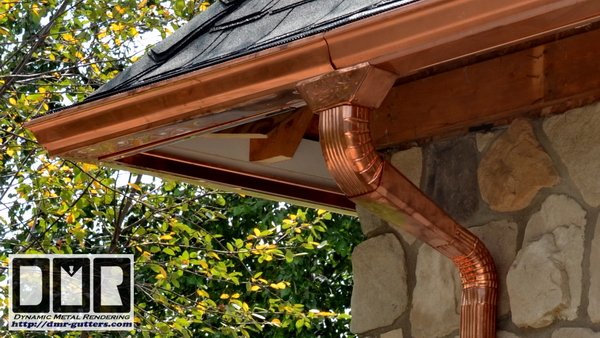 Although,
it is very rare to see gutter contractors utilize and expansion joints, it
is unwise to install a gutter longer than 40' to 50' long. Especially if
there is a corner at the ends of that gutter run. Consider how any metal
will expand and contract differently than a wood structure that it was mounted
onto. Gutters should never be
installed in such long continuous length, and most gutter contractors know
this. With even just 1/4" movement from this
expansion and contraction at the corner, it will rip the corners open within
the first year of changing seasons.
There is a reason they make rubberized expansion joints for
this purpose. There are a few other better ways that I create these
necessary
expansion joints on most of the gutter job we do. Yet, this is extremely rare
to see done by other Gutter Contractors; when all they are required to do is
get past the minimum 1-year minimum installation warranty, which defeats the purpose of using a
long-lasting metal that will not rust out. Without this carefully
implemented, I would say there are no other truly professional installers out
there, since they are not willing to redesign your gutter system with this
in mind, or teach
their installers to utilize any sorts of expansion joints. Although,
it is very rare to see gutter contractors utilize and expansion joints, it
is unwise to install a gutter longer than 40' to 50' long. Especially if
there is a corner at the ends of that gutter run. Consider how any metal
will expand and contract differently than a wood structure that it was mounted
onto. Gutters should never be
installed in such long continuous length, and most gutter contractors know
this. With even just 1/4" movement from this
expansion and contraction at the corner, it will rip the corners open within
the first year of changing seasons.
There is a reason they make rubberized expansion joints for
this purpose. There are a few other better ways that I create these
necessary
expansion joints on most of the gutter job we do. Yet, this is extremely rare
to see done by other Gutter Contractors; when all they are required to do is
get past the minimum 1-year minimum installation warranty, which defeats the purpose of using a
long-lasting metal that will not rust out. Without this carefully
implemented, I would say there are no other truly professional installers out
there, since they are not willing to redesign your gutter system with this
in mind, or teach
their installers to utilize any sorts of expansion joints.
As long as there are enough outlets, I will split long gutters
up by placing two opposing end-caps with at least a 1/2" gap between
them fro this pourpose. I then cap over
the two end-caps, so it will not dribble between them. I then make a
short piece of gutter to cover those end-caps from underneath to hide that
gap. This
has an additional benefit, making the gutters more modular. If a
large tree branch falls and dents the gutter, or a delivery van backs up
too far and
crushes the gutter there is only half the gutter to replace, which happens
all too often. I also
implement a custom expansion joints at the outlets where possible. I
designed a special
tray that I make, since I could not attach an elbow to those 2-ends of the
gutter that need to be able to move a bit, as shown here in this photo on
a job I was asked to do in Canton Ohio back in 2013. Yes, 2,500 miles away.
|
|
Sealing Corners
& End-caps on Gutters
|
What
about sealing the necessary seams on gutters?
How many rivets can you count on this outside corner piece of copper gutter?
Most Gutter Contractors install the flat face fascia gutters and a cheaper
caulk, because those corners are so much easier to miter than my K-5 style
gutter profile. Most of the gutters I have removed had less than half a
dozen rusty zip-screws holding a corners together. It is very rare to
see rivets used. This fact is proven by what is sold at the 6 different
gutter supply warehouses within the Portland metro area. The zip-screws they use are a cheap and quicker way to bond
2 layers of thin sheet metal together, where the screw cuts through the 2 layers,
pulling the second layer towards the first layer after stripping out that
first layer, and hopefully not over doing it, which would strip out both
layers and not hold them together at all.
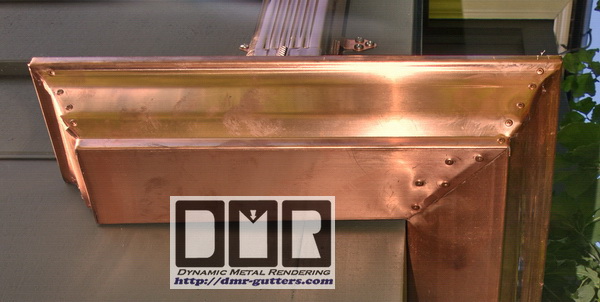 With rivets I have to first pre-drill an
1/8" hole through both layers, load the rivet tool work the rivet into the
holes, press those layers tight together, and squeeze the hand tool to swell the other end of the
blind-rivet, which
bonds those 2 layers together. This riveting would only fail the way
zip-screws do if I were to use a drill bit that was too large for those
rivets. Those
zip-screws are not a rust-free aluminum, or stainless steel, so they will
fail either way over time and leave a sharp point inside the gutter that you
will cut your hands on when cleaniong out the gutter several times a year. The rivets I use are made with the same type of
metal as the gutter, so they will not cause galvanic corrosion. Also, I used 14 to
20 fasteners on each corner. When
they use so few fasteners in a corner and no expansion joints (as described
in the section above) it is bound to fail within the first year of the
changing seasons, right after the new gutters were
installed. With rivets I have to first pre-drill an
1/8" hole through both layers, load the rivet tool work the rivet into the
holes, press those layers tight together, and squeeze the hand tool to swell the other end of the
blind-rivet, which
bonds those 2 layers together. This riveting would only fail the way
zip-screws do if I were to use a drill bit that was too large for those
rivets. Those
zip-screws are not a rust-free aluminum, or stainless steel, so they will
fail either way over time and leave a sharp point inside the gutter that you
will cut your hands on when cleaniong out the gutter several times a year. The rivets I use are made with the same type of
metal as the gutter, so they will not cause galvanic corrosion. Also, I used 14 to
20 fasteners on each corner. When
they use so few fasteners in a corner and no expansion joints (as described
in the section above) it is bound to fail within the first year of the
changing seasons, right after the new gutters were
installed. Amateur installers will
always buy the thin-metal factory-made corner pieces for the K-5 style
gutters, but the better installers will miter their own corners, so there is only one
potential leak, instead of three seams. If you see those pre-formed
corners, it is very
telling of the installer's incompetence, and there are most likely many
issues that are lacking with their installation as well. They do not sell corner pieces for anything
other than a common 90 degree outside or inside corners, so this leaves
those unskilled installers lacking to complete many gutter jobs that have
other angled corners to do.
Sealants?
How we seal a
corner makes all the difference. In the old days all they had was
solder to seal gutters with, since they did not have the advanced caulks
we have access to these days, but it is now very rare to remove old gutters that
had been soldered together. It worked plenty well, but it was
dangerous to have an open flame torch so close to the wood structure and
burning the paint. Solder was not a sealant
that could be used on aluminum gutters. I use a caulk called ProSeal
34, which cost over 3X more than the caulk sold at the local
wholesale gutter parts suppliers, since other Gutter Contractors are too
cheap to get the best caulk, the Suppliers have no reason to stock what I
have used on each gutter job over the last 2 decades plus. It is a sad
fact that I am still the only Gutter Contractor in
the area to buy this better caulk. We also use this caulk and copper
rivets on the copper gutters we install, instead of soldering the seams
together.
 |
|
What About Roof Valleys? |
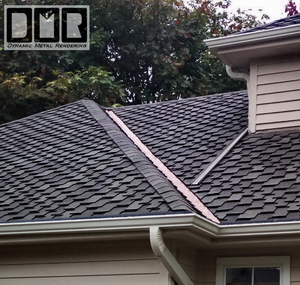 What
can be done about the river of rain water pouting out of my roof valleys and
shooting out over the gutter? What
can be done about the river of rain water pouting out of my roof valleys and
shooting out over the gutter?
I've had a shield
made and attached to the top of the gutter over the inside corners, but it
looks ugly. Is there a better solution? Valley
are certainly a Gutter
Contractor's curse. To deal with this sort of rain management night-mare on
many residential roof situation has proven to be far too much for most
Gutter Contractors. It's also an issue where an upper gutter
drains onto a roof (as seen in this photo). This is commonly the worst
problem area of a roof line we face. There is no type of screen that can be used
to cover a gutter at the base of a roof valley or an upper downspout. At
least here in the Northwest, where we have lots of very tall trees
overhanging the roof. It
will just become clogged up with debris before long and carry the rain water
out past the gutter. Even without a screen over the gutter it is very common
to see it shoot
out over the gutter at these inside corners. In most
cases there is a very simple solution of cutting into the bottom of the
metal valley pan to bend the edges downward in order to wick the water down
into the gutter, yet for some strange reason this logic has
eluded most every Roofer in business for many decades now. With this simple
solution there is no need for those unsightly shields mounted over the
gutter rim. It is best if it has a soft curve downwards. Not a sharp bend. I
tend to
make this adjustment in the course of replacing gutters, so this issue is
resolved. Although, this is not a common practice, even when you have begged
the Gutter Contractor to solve this issue.
 Since we cannot cover the gutter with screen
in these areas a good amount of debris will be collected in the valleys and forced
down into the gutter
and clog it up very quickly, required frequent maintenance, which is another reason the larger outlet
and Leaf-catcher option
is so imperative. I commonly can shove a screen that is curled upwards at the
base
of each valley to hold the accumulated debris up in the valley while
allowing the rain water to strain through into the gutter, but the down
side is how it will rust out the steel valley that much sooner and possibly
becoming a damn that could force water up under the shingles if not cleared
out regularly. The screen would help slow down the
water a bit, but may also make the water splatter out some. I wish
there were a perfect solution to this, but to date I've yet to find a better
way of dealing with roof valleys at any cost. Since we cannot cover the gutter with screen
in these areas a good amount of debris will be collected in the valleys and forced
down into the gutter
and clog it up very quickly, required frequent maintenance, which is another reason the larger outlet
and Leaf-catcher option
is so imperative. I commonly can shove a screen that is curled upwards at the
base
of each valley to hold the accumulated debris up in the valley while
allowing the rain water to strain through into the gutter, but the down
side is how it will rust out the steel valley that much sooner and possibly
becoming a damn that could force water up under the shingles if not cleared
out regularly. The screen would help slow down the
water a bit, but may also make the water splatter out some. I wish
there were a perfect solution to this, but to date I've yet to find a better
way of dealing with roof valleys at any cost.
Most
every dormer I've come across which had gutters also have no downspout.
The previous Gutter Contractor had just cut the gutter open back where
the gutter meets the roof to dump all the gunky gutter water on the roof
just below that valley, which creates a moss trail down the roof and
horribly wears those shingles prematurely from the river of water
flowing down in such concentration in those one areas. That
is why for the last 20+ years I've always sealed the end of the gutter
there at the base of the valley to catch the rain water coming out of
that valley above. Then it is directed down to the lower gutter via a
downspout and a custom roof tray we form and mount on the roof with
stainless steel screws, so this river of rain water will be delivered to the lower
gutter without touching the shingles. A detail I've yet to see done by
any other Gutter Contractor in this area. You can see how I form this
seal if you follow this link:
http://dmr-gutters.com/cg/Kistler5.htm#Custom
After doing it this way for over 2 decades I seem to be on the right track
with no complaints. That stat surprises me as well, since nothing is
perfect. |
|
Colors
to Choose From |
| What
about pre-painted colors?
The aluminum gutter coil I buy from the the 2 main local Suppliers I
use comes pre-painted in about 40 different
neutrals and colors (see my Colors web
page to see the list). They have not changed the painting technology much in
the last few decades. This is a baked on enamel finish, like a
car finish, yet not quite as durable, but is still better and smoother than any paint you can put over them, like
a heavy house
paint. Even the touch-up spray paints sold at the same wholesale
gutter parts suppliers are noticeably inferior to the original baked on
finish these parts come in, which fade and peal off much sooner. I do stock gutter coil and
all the downspout parts in each color, but the Wholsale Suppliers do, so
they are readily available.
Can they be pained later?
Sure. These can be painted over as long as they are new or have been carefully cleaned, but it would require a lot of added labor and cost to paint the gutters and downspouts in the color you want. For touch-up it is recommended to use a light bodied spray paint, as opposed to a thick lumpy house paint. Years latter it is not going to leave such a thick ugly peal, which may be more trouble and costly to scrape smooth than it would be to replace all the gutters. I can sell you cans of matching paint, but it will fade
and peal much faster than the original paint
What if your colors do not match my trim
paint?
Most of the colors are earth tones. If you can find a good color match, or a color
you like, you would do well to get your gutters in that color, and maybe
re-paint the rest of your trim to match, if needed. Most
all other installers will charge you extra for colors other than white or dark
brown that they keep in stock. They have done this so much now that
they have trained most Homeowners to the point that white gutters account
for around 60% of what is
being installed. It is of course simple to
just draw from their stock of white parts they can buy in volume.
I actually discourage our Clients from choosing white or other light
colors, because it
shows mildew stains so badly. Like buying a white car and needing to wash
it twice as often. I feel that
it ought to be a matter of customer service to provide the right color
suited for your house. It is true it does cost me more to
provide other color options and have to make these small purchases for
each gutter
job. It is a hassle to spend an extra part of my day getting
those other colored parts, not to
mention having to spray paint the corners and the other specialty downspout
elbow parts I use (especially
on a rainy days). But I would rather it look right, like it was meant to
be on your house, and you feel good about my work when I am done. It
is much better for my referral business as well.
|
| Downspouts
& Elbows |
|
What
about downspout elbows I see on other houses?
I stock 3 times as many types of
downspout elbows as other installers, to give your house a more customized fit.
But
these specialty parts don’t come in all those other colors. I stock
them in white and have to use the touch-up spray paint to get them to
match. Of course with copper parts this is simply not an issue.
In fact, when they put up
fascia gutters, they don’t use any elbows at all. They just cut into the side of the
strait downspouts with a hacksaw and fold it. This cheap method is notorious for getting
debris clogged in the downspouts. The fascia gutter bottoms are so narrow,
they are also unable to utilize the
oversized downspouts we offer for a no-clog gutter. We have even seen recent
Street of Dreams homes with copper gutters that had the same sort of
plain square downspouts and did not have any curved elbows? That was
insane!
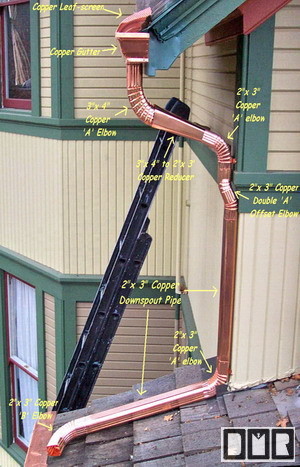 
The
smooth rectangular steel downspouts they use are even smaller than the standard corrugated
aluminum down spouts that I use. I can fit those downspout inside the
ones I use. I also attach the downspouts with a thick bracket that I
rivet on the backside, and anchored with special coated Phillips screws for easy removal.
This way you can paint behind it, or access the underground drain if needed.
I have seen a lot of downspouts detach from the bottom
of the gutter, so I install the first elbow onto the bottom of the gutter
with caulk and rivets before I install the gutter. I then double rivet
each elbow attachment together, except the one elbow already on the
gutter, so the downspout can be removed if needed without damaging those
downspouts.
You can read more about this topic on my Downspout
Comparison web page:
http://dmr-gutters.com/ds.htm
|
| Leaf
Catchers |
|
 What is a Leaf-catcher? What is a Leaf-catcher?
Simply speaking it is a gutter debris strainer that is mounted lower
to the ground in the downspout, where the Homeowner can easily access it
without a ladder or tools, instead of having to get up on the roof in the
worst weather, when you finally
notice you have a problem. A strainer up in the gutter outlet may help to keep
the underground storm drains clear, but they are death to gutters and should
be avoided.
The only purpose of
a Leaf-catcher (as seen to the left) is to protects the underground
storm-drain pipes from getting jammed up with debris, but you want the
gutters to continue to function and do their job to catch the rain water and
deliver it to the storm drains. These storm drain pipes are there to
carry the excessive rain water safely away from the house foundation. Without these
storm-drain pipes in good working order
you are better off with no gutters at all and allow the rain water to
dribble off the roof edge evenly along the whole roof line and hit the ground at
least as far away from the foundation as the width of your eaves. A clogged
gutter is also worse than having no gutters; with it continually overflowing
at the low spot on the gutter.
I price Leaf-catchers on each bid when there is underground storm
drain pipes. We are not the only source for this type of device, but
I have personally made several design improvements over those other
designs, and we fabricate these Leaf-catchers ourselves with aluminum or copper sheet
metal, which is thicker than what is used for downspouts. Along with a high grade stainless
steel
screen, which is stronger than any other. A raccoon could not claw through
this screen.
We place this strainer in the downspout about hip height with this screen to catch the
leaves before they can clog up your under ground storm drain pipes. It’s a bargain at
$60 to $80 each, compared that to the $75.00 or more per hour that Roto-Rooter
type companies will charge you to attempt to clear out your underground
storm drain pipes.
If you are not local to us, you can still order them through our
Parts
Shipping web page with a satisfaction guantee. You will also find detailed installation
instructions. We also provide the special pipe cleats to remount the
whole downspout, the rivets to connect it all, and even the stainless
steel #3 Phillips screws to mount the downspout back on the siding, as seen
in this photo. |
